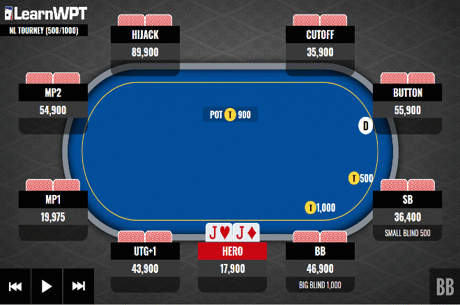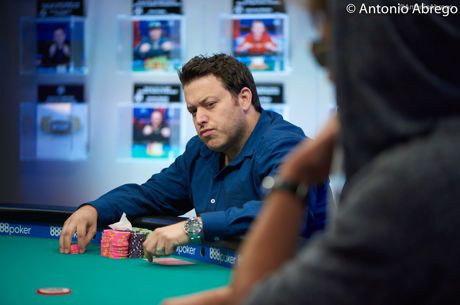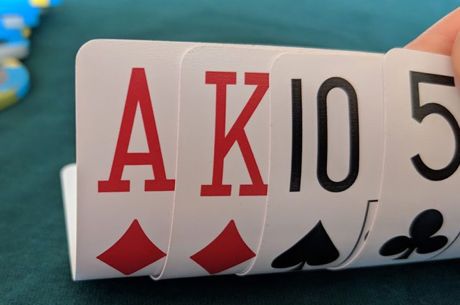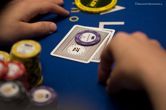Tommy Angelo Presents: Waiting for Straighters, Part III - Taming Tilt and Plugging Leaks
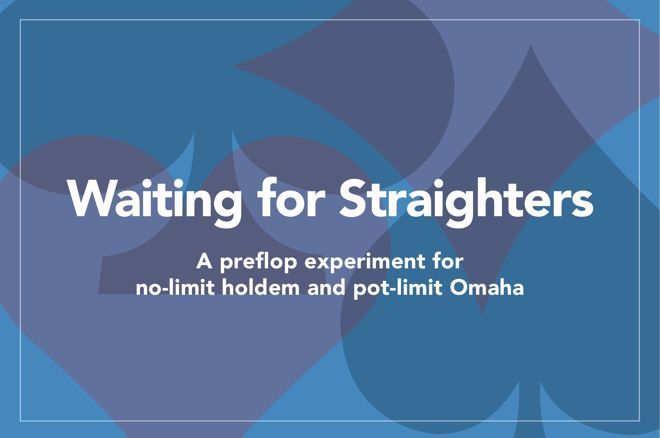
Introduction to Episode 5
In hold'em, a straighter is a hand that can flop a straight. 6-2 is a straighter. 7-2 isn't. In pot-limit Omaha, a straighter is a hand with no pairs, no aces, and no more than two gaps. J-9-8-6 has two gaps, so that's a straighter. J-9-8-5 has three gaps, so it's not.
Waiting for straighters does not mean wait until you get a straighter and then play it. It means wait for a straighter, at least, and then maybe play it. In other words, fold the non-straighters. That's the gist of this article.
And we are now at the end. Here's what I wrote at the beginning, about the ending:
The last part is called Using WFS to Tame Tilt, Plug Leaks, and Reduce Fear of Self. If the Waiting for Straighters experiment appeals to you, I don't think it will be on strategic merit alone. It will be because something in the final chapter makes sense to you and resonates.
PART III �� Using WFS to Tame Tilt, Plug Leaks, and Reduce Fear of Self
I play and teach under the assumption that tilt reduction, leak reduction, and fear reduction are profitable pursuits because they rate to improve one's score. This section is about making money, and living an easier poker life, during sessions and in between, by lightening the mental load.
You can use WFS to reduce tilt, which I defined in Elements of Poker as any deviation from your A-game and your A-mindset. From that perspective, reckless betting is the same as fatigue is the same as boredom. They're all varieties of tilt.
And you can use WFS to plug leaks. Leaks are the effect of tilt. When you feel impatient, that's tilt. When impatience causes you to play a hand that you think you should fold, that's a leak. When the desire for revenge is burning inside you, that's tilt. When you keep attacking the one player who keeps beating you, that's a leak.
And, you can use WFS to make yourself less fearful of your own tilting and leaking.
Here's how waiting for straighters has helped to pave my path to painless poker��
Plugging Leaks
Recall that in 2004, I sat alone on my couch and filled out Earl's chart with my starting hands for limit hold'em. Here's the rest of that story.
My gut knotted up halfway through the first box. I knew that if I kept going, I'd expose myself to myself as a fraud. My hypocrisy would have no place left to hide.
I kept going anyway. I peered into each preflop situation �� There's one raiser and I'm in the cutoff �� and I asked myself �� What is the worst hand I should play in this spot?
Then I littered the page with my shattered delusions. I was finally forcing myself to face the fact that in the fog of war, I play more hands than I think I should. Not only did I not practice what I taught, I didn't even practice what I thought. I mean, I did, most of the time. But this game isn't about most of the time. It's about having an edge all the time, as big as it can be. That was the code I lived by. It was my identity. By filling out the chart, I was rooting out my leaks and writing them down. And from that day on, I could no longer pretend that I wasn't a pretender.
Unless I stopped leaking.
Ha! There's a fantasy for you.
Hey, you never know. Maybe the pain of knowing how bad I play will somehow deter me from playing bad.
Dream on.
I finished filling out the chart. A year later, I filled it out again, this time for no-limit. Then again, a while after that. These were more like spasms of compulsion than what I would call "work."
Whatever it was, the result was awesome. Two big upgrades came from messing with the chart. By asking myself, What do I do and why? in the 40 most common preflop betting patterns, I refined my A-game. And by deciding to fold certain hands in certain situations no matter what, the chart worked like a scalpel and lopped off ugly growths of C-game.
(You can download the chart along with instructions at my website, in Word and Excel. I call it the Universal Starting-Hand Chart because it's blank, until you set the scene.)
Less Tilt and Less Fear
The line between 3-gappers and 4-gappers was a line I could see. And it did not waver, no matter how frustrated I was, or angry, or anxious, or downtrodden. WFS became a do-not-cross line. If I stayed on the safe side, survival was guaranteed. If I crossed the line, well, it would by no means mean certain death. I might even make more money. I would also expose myself to the pain and complexity that only exists on the danger side of the straighter line, where I lived for many years. It was a grand time. I was able to satisfy my cravings for sporadically irrational aggression and still make a good living. Then I became older, and now I value simplicity and peace of mind.
The reason WFS reduced my tilt was because I was trimming off the very worst of my preflop situations, the plays that generated the most variance and the least profit. WFS removed the moments of highest consternation and aggravation from my game. By saying no to marginal situations, I had less fluctuation, which resulted in less tilt and better focus. And that caused my earn rate to go up, which incented me to hold the line.
(Lowering one's variance also lowers one's bankroll needs, which is not in itself a reason to favor less variance, but it sure can come in handy at times.)
By waiting for straighters, I was also pruning the times I got too frisky with lousy hands. I did this by rigidly defining the term lousy hands. The idea was to always fold these hands �� even if I was playing my loose-aggressive style, and even if I was suited, and even if I was on the button and everybody limped, and even if I was in the small blind and everybody limped �� K-8, K-7, K-6, K-5, K-4, K-3, K-2, Q-7, Q6, Q-5, Q-4, Q-3, Q-2, J-6, J-5, J-4, J-3, J-2, T-5, T-4, T-3, T-2, 9-4, 9-3, 9-2, 8-3, 8-2, 7-2.
I swore an oath to John Lennon to dump my dumper hands no matter what. Of course I broke the oath, tons of times, but that was okay because I retook it, and retook it, and after some number of years, I got there. That was about seven years ago. That's how long it's been since I've paid to see a flop with one of my dumpers.
At the same time, I swore a different oath of tightness (this one to John Bonham) regarding my miniscule opening range from the early seats. I've held to that oath for a long time too, and now I'm never in shitty pots with shitty cards and shitty position unless it's a free play from the big blind. And I do mean never. Whew! What a relief. Gone are my fears of leaking and tilting. And now poker feels �� and I don't think I've seen this word used in this context �� easy.
The Difference that Makes the Difference
To play or not to play. That is the question. Whether 'tis nobler in the mind to suffer the slings and arrows of middling starters out of position, or to take arms against a sea of troubles, and by mucking, end them.
I actually know the answer to that one. 'Tis nobler to muck.
To play or not to play, that really is the most important question. It doesn't matter if the game is draw poker, stud poker, or a game of flops. The first round of betting is in a class of its own. Is it profitable to invest in this hand in this situation against these players at this time? Lines must be drawn, consciously or otherwise, betweens Invest now and Wait for a better spot.
Playing NLHE, I'm on the button with J?7?. Three players limp. This is a no-brainer. I either call or raise. If I have J?6?, it's also a no-brainer. I fold. I have concluded that for me, in this situation, the straighter line is the difference between +EV and -EV.
Playing $5/$10 PLO, I'm in the small blind. Under the gun limps and it's folded to me. I look left and I can see that the big blind is not going to raise. With 9?8?7?5?, I toss a $5 chip in. With 9?8?7?2?, I toss my cards in.
Playing $5/$10 NLHE, I'm on the button. It's folded to the cutoff who opens for 3x. With A?10?, I might fold, I might call, or I might raise, depending on the usual slew of variables. With A?9?, I used to maybe play it in this spot, but now I always fold because (1) I wait for straighters, and (2) I don't want to be haunted by Bobby Hoff.
Have I drawn my lines in the right place? I have decided to believe that I probably have. The cool thing is, I'll never know if I'm right to wait for straighters. Such is the nature of live cash-game poker. The EVs of our decisions are always unknown, and unknowable. I like that. Actually, I rely on it, to keep me from spiraling into self-doubt.
Waiting for straighters isn't about making straights. It's about winning more big pots than you lose. It's about acting last more often than they do. It's about maintaining power over the people, and control over yourself. WFS is not a strategy, it's an experiment. Will it yield positive results? There's only one way to find out.
Waiting for Straighters is available in ebook and audiobook at all the usual places.
- Part I - Discovery (Episode 1)
- Part II - No-Limit Hold'em (Episode 2)
- Part II - Pot-Limit Omaha (Episode 3)
- Part II - Strategy Merits in PLO (Episode 4)

World-class coach and author Tommy Angelo is now offering poker pain relief to everyone. You can schedule a call to talk to Tommy about bad betting, bad quitting, bad tempers, or whatever else is hurting your game. Just go to tommyangelo.com. Angelo's first book, Elements of Poker, was called "the seminal poker text of the 21st century" by The London Times, and it has revolutionized the way serious players approach the game.
In this Series
- 1 Tommy Angelo Presents: Waiting for Straighters, Part I - Discovery
- 2 Tommy Angelo Presents: Waiting for Straighters, Part II - No-Limit Hold'em
- 3 Tommy Angelo Presents: Waiting for Straighters, Part II - Pot-Limit Omaha
- 4 Tommy Angelo Presents: Waiting for Straighters, Part II - Strategy Merits in PLO
- 5 Tommy Angelo Presents: Waiting for Straighters, Part III - Taming Tilt and Plugging Leaks

